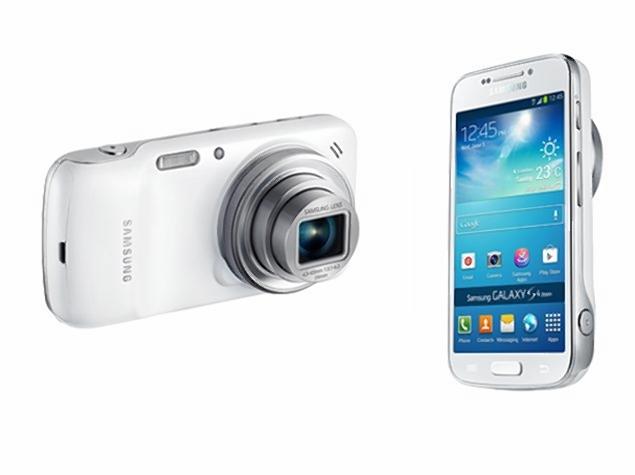
A heftier point-and-shoot camera than some of its predecessors, the Samsung S4 Zoom has found a niche in buyers who double as casual photographers, and who want a basic digital camera with their smartphone.
There are smartphone cameras and there are good smartphone cameras. And then there is the Samsung S4 Zoom.
It’s been a year for trying new things on smartphones (see Nokia’s brilliant Lumia 1020, HTC’s super-sexy One and Samsung’s monstrous Mega) and Samsung is at it again with the S4 Zoom. Samsung continues to position itself as a company that’s willing to embrace forward-thinking, unique ideas and they don’t get much more unique than this.
The S4 Zoom is Samsung’s second try at smartphone-camera lovechild. A year ago, the company delivered the Galaxy Camera, a hefty full-function digital camera that essentially had an Android-based interface grafted to its back. It was a good camera, one that served me well during a few days of tourism in San Francisco, but as a first attempt, it had obvious imperfections. It was large and ungainly, barely squeezing into my back jeans pocket, and because it wasn’t a full-fledged smartphone, I couldn’t take it out on the town alone.
The S4 Zoom solves all those problems, delivering a dream Android phone for the point-and-shoot crowd. Forget your iPhone, your Galaxy S4 and your Droid Maxx. If you love fiddling and zooming and tweaking, you’ll love the S4 Zoom, which is potent camera and solid smartphone all rolled into one.
At 10.7 ounces, the S4 Zoom isn’t exactly light and super-sexy as a smartphone, and it’s even a bit hefty for a point-and-shoot. But it no longer feels massive, and you can fit it into your back pocket or your coat pocket without feeling like you’re carrying some giant paperweight.
It still feels more like a camera than a smartphone, so if you’re considering it, you want to be a member of the Bluetooth headset crowd. Talking on the S4 Zoom both feels and looks strange (yes, I got a few stares in the mall), although it definitely is possible.
Then again, if you’re buying this phone, it’s less to talk and more for all that photographic convenience. And it’s here that the S4 Zoom really excels.
No, it won’t compete with top point-and-shoots with a pretty basic 16-megapixel, BSI CMOS sensor on the back end. But this device still easily runs circles around basic smartphone cameras.
The zoom lens is a bit clunky and very loud and it’s a shame that you can’t control it via the touch screen, like a typical smartphone zoom. Samsung also falls behind the Lumia 1020, which can open the camera with a press of a button. You have to go to the camera app to get the camera working on the S4 Zoom.
Still, Samsung beats the Lumia, which had no SD card slot, by including the obligatory microSD card slot and making it far easier to access and control your photos. No need to access some locker here.
Shots were generally solid. My indoor shots were better than outdoor ones, and everything was sharp and clear. Fine details, however, aren’t as sharp as they are on the Lumia 1020’s 41-megapixel shooter. That’s a minor letdown considering the bulk of this phone, but the S4 Zoom’s shooter still delivers more clarity than, say, the original S4 and the HTC One. It’s an average point-and-shoot, but that’s more than an average smartphone.
The feel of a true point-and-shoot can’t be simply dismissed, either. This device is a camera through and through, and that’s satisfying and comfortable. At times, the Lumia 1020’s ultralight frame may make you a bit nervous that you might drop it, but there’s no sense of fragility with the Zoom.
That’s the big selling point of the Zoom: as a smartphone, it’s solid, but not nearly as spectacular as its cousins, the S4 and the Note 3. The little extra photo power is complemented by a tradeoff in phone power. Instead of a lustrous HD display that makes Netflix look grand, you get a 1,280×720 screen that looks good but not great. There’s no Snapdragon processor for gaming here, either, although the 1.5-gHz dual-core here can run the likes of Temple Run. Samsung also sticks with its trend of plastic bodies, a move that in this case helps keep the smartphone light.
These may seem like frustrating tradeoffs, but it’s more than likely Samsung knowing its audience. This is a niche device, but the crowd that wants an S4 Zoom doesn’t necessarily want to game or watch movies; if the audience did, it’d steer towards that magical Note 3.
So by not throwing everything but the kitchen sink into the Zoom, Samsung is able to keep costs down, delivering a smartphone that’s $149 on contract from AT&T, $50 cheaper than that Lumia 1020 (another AT&T exclusive), and other comparable devices such as the S4 Active and the aging Note 2.
It adds up to solid value, even if the S4 Zoom doesn’t quite match the Lumia 1020 overall. The Lumia’s lens simply delivers crisper, clearer photos; that Windows operating system is underrated; and the light unibody design exudes sleekness and style.
Still, the S4 Zoom has plenty of appeal as the best smartphone-camera blend on the Android market, and you have to give Samsung credit for continuing to push innovation. This is the company that made the phablet cool, delivered a stylish (if somewhat flawed) phone for more rugged use in the S4 Active, and in general has pushed more and more devices for niche crowds instead of simply designing for the masses.
And the S4 Zoom definitely has a crowd. Despite its imperfections, it’s better than a basic smartphone camera at birthday parties and even during light sightseeing.
And it’s different. And this year, that’s what Samsung’s been all about.
[NYDailyNews]

